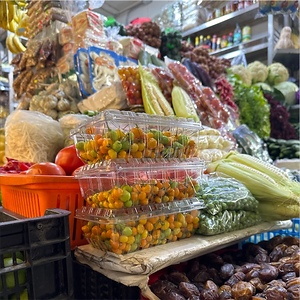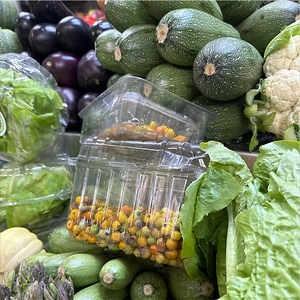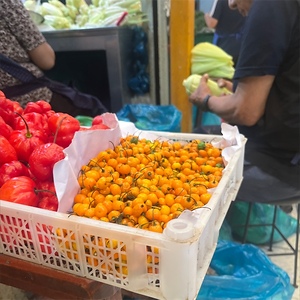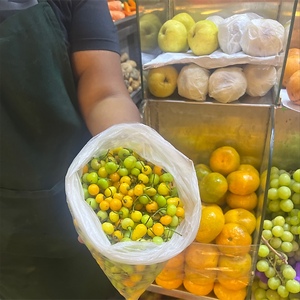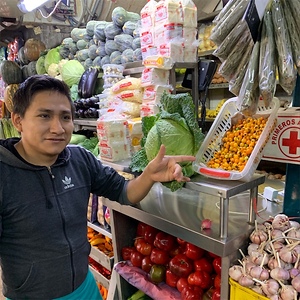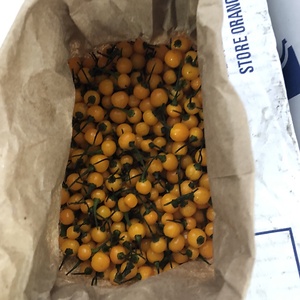

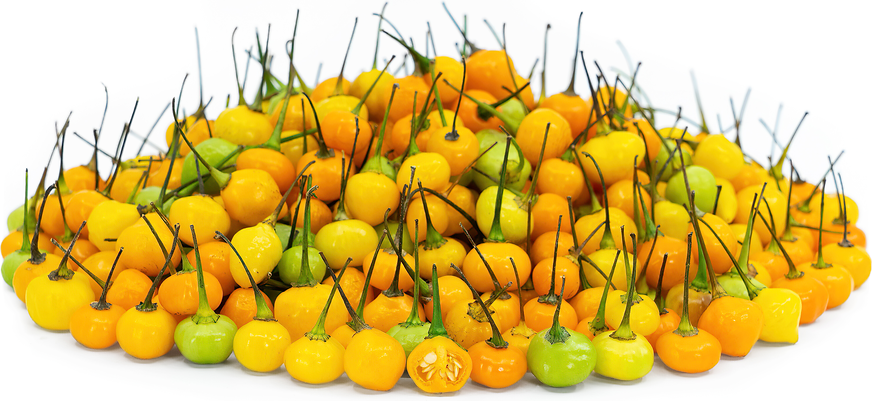
Aji Charapita Chile Peppers
Estimated Inventory, lb : 0
Description/Taste
Ají Charapita is a small varietal, averaging 0.5 to 1 centimeter in diameter, and has a round, slightly tapered, or oblate shape with a slender, straight green stem protruding from the top of the pod. The petite peppers are about the size of a pea and have thin, glossy, firm, taut, and smooth skin, transforming from green to shades of yellow, orange, and yellow-orange when mature. Underneath the surface, the flesh matches its exterior hues and is aqueous, crunchy, and chewy, encasing a cluster of tiny, cream-colored seeds in a central cavity. Ají Charapita has an initially bright, fruity, and citrusy taste followed by a moderate to hot spice level that gradually builds in intensity and has a slow burn. The pepper’s flavor will vary, depending on the coloring, and green pods will showcase grassier, green nuances, while yellow and orange pods have a tangier, sweet, floral, and fruity taste.
Seasons/Availability
Ají Charapita is available year-round.
Current Facts
Ají Charapita, botanically classified as Capsicum chinense, is a pepper native to South America, belonging to the Solanaceae, or nightshade family. The tiny round pods grow on bushy plants extending over one meter in height and are picked fresh for use in culinary preparations. Ají Charapita is known by several names throughout South America, including Wild Peruvian Chili, Tettinas de Monk, Charapilla, and Ají Charapa. The variety has moderate heat, ranging from 30,000 to 50,000 SHU on the Scoville scale, and is revered for its fruity flavor. Ají Charapita is thought to have origins in Amazonian Peru and is not commonly found outside of its growing region, leading the variety to be one of the rarer premium peppers in markets. Despite its limited availability, Ají Charapita is used in a wide array of savory culinary preparations and is typically consumed fresh. It is also occasionally dried for extended use.
Nutritional Value
Ají Charapita is a source of vitamin A to maintain healthy organ functioning, vitamin C to strengthen the immune system, and potassium to balance fluid levels within the body. Chile peppers also provide some iron to develop the protein hemoglobin for oxygen transport through the bloodstream, magnesium to control nerve functions, and other nutrients, including B vitamins and riboflavin.
Applications
Ají Charapita has a zingy, fruity, and citrusy taste suited for fresh or cooked preparations. The small pods can be consumed fresh or are commonly squeezed with a fork to extract the juice. When raw, Ají Charapita can be finely chopped and mixed into salsas and sauces or sprinkled over soups and stews. In Peru, the extracted juice is the most traditional method used in jams, condiments, marinades, and sauces. The juice invokes a tropical flavor mixed with moderate heat and is incorporated into a popular Peruvian condiment known as “criolla,” made with lightly crushed Charapita, lime juice, red onion, salt, and water. Ají Charapita is also combined with cocona, an acidic fruit, to make a tangy, bright sauce. The peppers can be mixed into spice blends, served with various seafood, or combined into dishes for added zest. Ají Charapita pairs well with meats such as pork, beef, and poultry, potatoes, tomatoes, herbs including cilantro, parsley, and huacatay, aromatics such as red onions, shallots, and garlic, rice, and quinoa. The small peppers will keep for 1 to 2 weeks when stored whole and unwashed in the refrigerator. Ají Charapita can also be dried, ground into a powder, and used as a spice.
Ethnic/Cultural Info
Ají Charapita is a popular house plant in Peru, primarily grown and harvested as needed for culinary applications. The plants are often allowed to spread widely in home gardens, providing ornamental appeal, and are mainly present in the Loreto and San Martin regions of Peru. Ají Charapita is used in many traditional Peruvian jungle dishes such as Juanes, which is a mixture of meat, hard-boiled eggs, spices, and peppers wrapped in bijao leaves and cooked. The leaves impart a unique flavoring to the rice dish, and the mixture is typically served with cooked bananas or cassava. The name Juanes refers to Juan Bautista, translating to John the Baptist. Juanes is a traditional dish consumed during the feast of San Juan on June 24th. It is said that John the Baptist is the patron saint of the Peruvian Amazon as the saint is tied to water, the lifeblood resource of the Amazon. During the celebration, feast attendees complete several rituals, such as bathing in rivers and participating in community processions. Juanes is the customary dish served between friends and family, and legend has it that the small leaf-wrapped parcels are said to resemble the head of John the Baptist, paying homage to his famous beheading in religious texts.
Geography/History
Ají Charapita is native to the Amazonian jungle regions of Peru, specifically near the city of Iquitos. The species has been cultivated since ancient times and has remained a pepper mostly localized to its native growing regions. Ají Charapita is primarily a wild species and has only recently been commercially cultivated. Today, Ají Charapita is available fresh through markets in Peru. The variety is also dried and sold as an exported good throughout the Americas. Dried versions are kept whole or ground into a powder and used as a spice. Ají Charapita seeds are also available through online seed catalogs for home garden use.



